Two weeks ago, on January 29—nine days after the inauguration—I gave a talk at the Headlands Center for the Arts, at the invitation of my friend Stephen Steinbrink. He played a set of songs afterwards, which was perfect. If you want to approximate the experience, read this newsletter and then go listen to Step’s songs! Before the talk and music, I ate a fabulous dinner prepared by chef Damon Little in the dining hall with many strangers and some friends.
I felt super super nervous standing up to share this talk, because I worried it was about… nothing. I still harbor that fear, but I got enough grateful, sigh-laden feedback from friends and strangers to feel compelled to share it here, too. One artist came up after the talk, almost shaking, to thank me for for using the time to talk about (gestures around) *all this* instead of my artwork. I was like “Wow thank you, yeah, I couldn’t imagine talking about anything else right now, but also… I think this is my artwork?” We laughed, we hugged. Emotional slideshow presentation, my favorite artistic form.
Here’s how it went.
1. Frameworks for Formless Things
My studio is no longer here at Headlands, but I’m imagining this talk to be kind of like a studio visit. Pretend you’re visiting a public open studios, or maybe we made a plan and you’ve come to my studio to have tea. You ask me, “What are you working on lately? What are you thinking about?”
I think a lot about this poem by Joanne Kyger. Like, almost every day. Like, when I’m cleaning up barf in the middle of the night, or when the door handle of my van pops off in my hand, or when I’m doomscrolling the headlines. This poem — all four lines of it — could, in some ways, be the title of this talk.
I should not assume that I know the shape of your feelings. But maybe I can guess.
Perhaps, like me, you find yourself descending into an anxiety spiral: deeper, dizzier, pulled into a coil of concern.
Perhaps, like me, you find yourself stuck in a web of connected horrors. Each heartbreaking thing leads to another, and look, all of these things are also connected to a common source (fascism). It feels like they all gain strength as they link together.
Lately I have been trying to discern the shape of my feelings. Maybe it’s because I am a graphic designer and I think visually, and maybe it’s because words feel tired. They aren’t working for me anymore: grief, anger, anxiety, sadness, outrage… they are losing their potency with so much use.
Since the words aren’t working, I guess I’m trying shapes now. Spatial understandings, or frameworks for otherwise formless things.
A month ago when Stephen asked me to speak, when I considered what I could POSSIBLY talk about a week after the inauguration, it was ALL doom spiral, all web-of-despair.
I was trying to to fit into twenty minutes: genocide, colonialism, the tech industry— specifically AI, the military industrial complex, all of these things’ impact on our poor sick planet, San Francisco astroturf groups, billionaires in general, the egg shortage, figuring out how to feed my family without compromising my values, the Bay Area affordability crisis, the everywhere affordability crisis, the impending displacement of ranch workers1 in the Point Reyes National Seashore, misguided federal bureaucratic power, powerful people hoarding wealth, and… wondering what kind of life my kid will have in this burning world.
So yeah, it was a lot.
But then my friend Cathy Kossack came over last weekend, and we walked to the farmers market with my kid, and the morning turned into an all-day hang. A kind of deep hang I haven’t had in years, since COVID and parenthood changed my life.
We filled the stroller with oranges and broccoli and eggs and honey. We walked the neighborhood and filled our pockets with lemons and kumquats. And I pitched this talk to Cathy while we walked, unloading the spiral. I was like, “Ok, and then I’ll talk about AI and the military and how AI branding is creepy and manipulative, so I guess I’ll also talk about design, and then I gotta work in arts funding coming from arms dealers, and somehow I’ll point out the cyber trucks charging at the hotel across the street from my studio as signals of the still-widening wealth disparity chasm in the Bay Area and…”
…and Cathy was very generous with her attention, but gently suggested I consider leaving the doom to the feeds we see everyday and use this time, together in a room with people, to wonder… what else? What next?
This was a good suggestion.
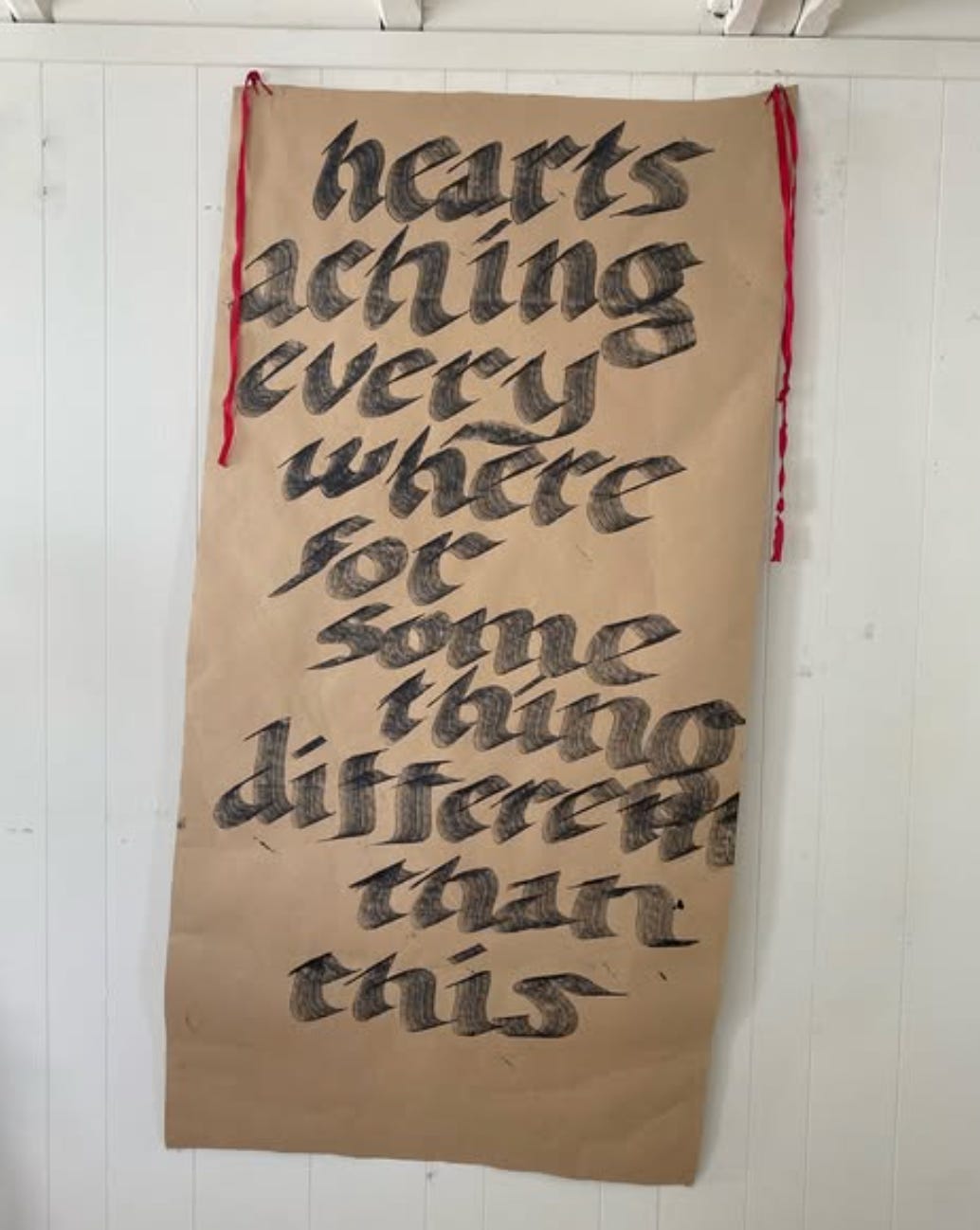
If we’re all aching, deep in our hearts, for something different than this — which I think we are — what do we do to remedy the aching?2
2. Spiraling in
Spiraling out — we definitely don’t want to do that. But what does spiraling in look like?
How might these symbols, the same ones I use to shape my grief, instead help me — help us — navigate this very dark present? I wonder if they might help me map solutions….and, actually, no, I don’t mean “solutions,” because that feels very… RESULTS! ORIENTED! It feels very corporate. I’m more interested in mapping towards like, a balm, or a tonic. Something that supports, or heals, or… provides revolutionary energy and connection and grassroots power. Which can also be a balm.
I want to spiral instead into infinite softness. To brush up more often against an understanding that I’m hanging onto the same thread, with all that came before me, and all that comes after me.
And even though I might feel like I’m operating in a vacuum, that all my meager efforts—my phone calls to my reps, my silly bumper stickers, my $5 GoFundMe pledges—that all my love and actions are isolated and separate and small… they’re not.
The artist Laurel Schwulst wrote about the spiral:
“To protect themselves from predators in their slowness, snails carry a shell. Snails are born with this shell, which is at first very tiny, colorless, and soft. It gradually grows with the snail’s body… French poet Francis Ponge described snails’ shells as ‘part of their essence’ but at the same time ‘a work of art, a monument,’ which ‘lasts longer than they do’.”
Ok. Now the spiral is feeling generative.
What can I make that will last longer than I do? What will be the monument to my time here on earth? What will constitute the thread that connects my timeline with my daughter’s timeline, with your daughter’s timeline?
The spiral is starting to feel less anxious and more like a mysterious and tantalizing unknown.
Of course, the universe is a spiral. Spirals have inherent strength in their structure. When I take a deep breath and consider the spiral, it’s difficult to NOT feel connected to something bigger. We’re all part of the soup, you know?
Spirals are considered an ideal ratio. And… cool, suddenly, more generative thinking. What is my perfect ratio: Of action to rest? Of softness to strength? Of love and care to outrage and refusal?
So, the spiral is giving infinite mystery, an invisible, unending thread that connects, that builds inherent strength, a delightful and nebulous infinity. But webs? Our other shape for tonight? They’re tangible.
Webs are drinking coffee with a friend. Webs are text messages to your young cousin who looks up to you. Webs involve spending time with people who are different ages than you. Webs are meal trains and group emails. And I’m not talking about the newsletter platform kind, or the BCC kind. I’m talking about the CC kind, where everyone can reply-all to everyone else, and it blows up your inbox in an endless thread. I know they’ve fallen out of fashion, but I think we might consider bringing those back. The moment may be ripe for them once again.
Webs involve showing up, in person, with your body, to a place where other people are. Webs emerge from intention, attention, and care.
The web, like the spiral, is a naturally occurring symbol. It’s not something we invented. The web is older than the internet.
Of course the internet is a web, and most visualizations online are kind like these techy, telecommunications, cover-the-earth renderings. Honestly when I see these I’m like, “Please, no! Leave the earth alone!”
I want to be clear that the web I’m talking about is more than this. Despite tiny computers in our pockets functionally connecting us to each other with more ease, they also isolate us from each other. So this wired, blue-light web is not the web I’m talking about.
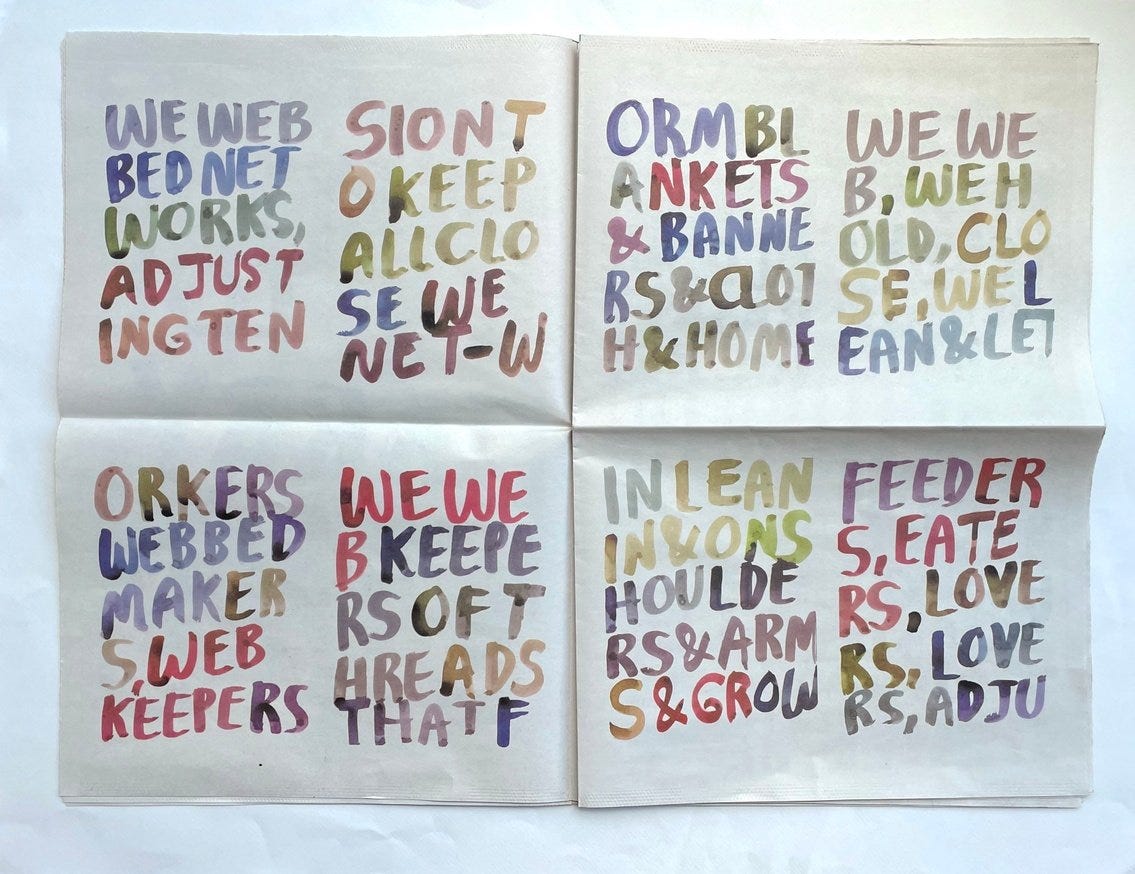
The artist Lukaza Branfman-Verissimo3 is working with the web I’m talking about. Their work deals in entanglements as social material. Their work builds and represents and enacts support systems and ecosystems of care, specifically for Black, Indigenous, Queer, Trans, People of color. About the project we web keepers, Lukaza wrote,
“we web keepers is connective tissue, baskets, nets, hands that hold, bodies that fight oppression, underground mycelium, seeds getting ready to sprout, ancestors we never got to meet, kinship so deep it reminds us of our multiplicity, chosen family, lovers, an ecosystem, a legacy of caring that holds us through the darkest days.”
I’ve learned a lot from Lukaza and their potent work over the years. But a crucial learning I carry with me from their work — one of the stickiest parts for me — is the understanding that webs require attention. Webs are not only a thing that we build, but a thing we must also maintain. Lukaza’s work teaches me that collective survival and the health of the web—as a net that could catch you if you need it to catch you—requires tending.
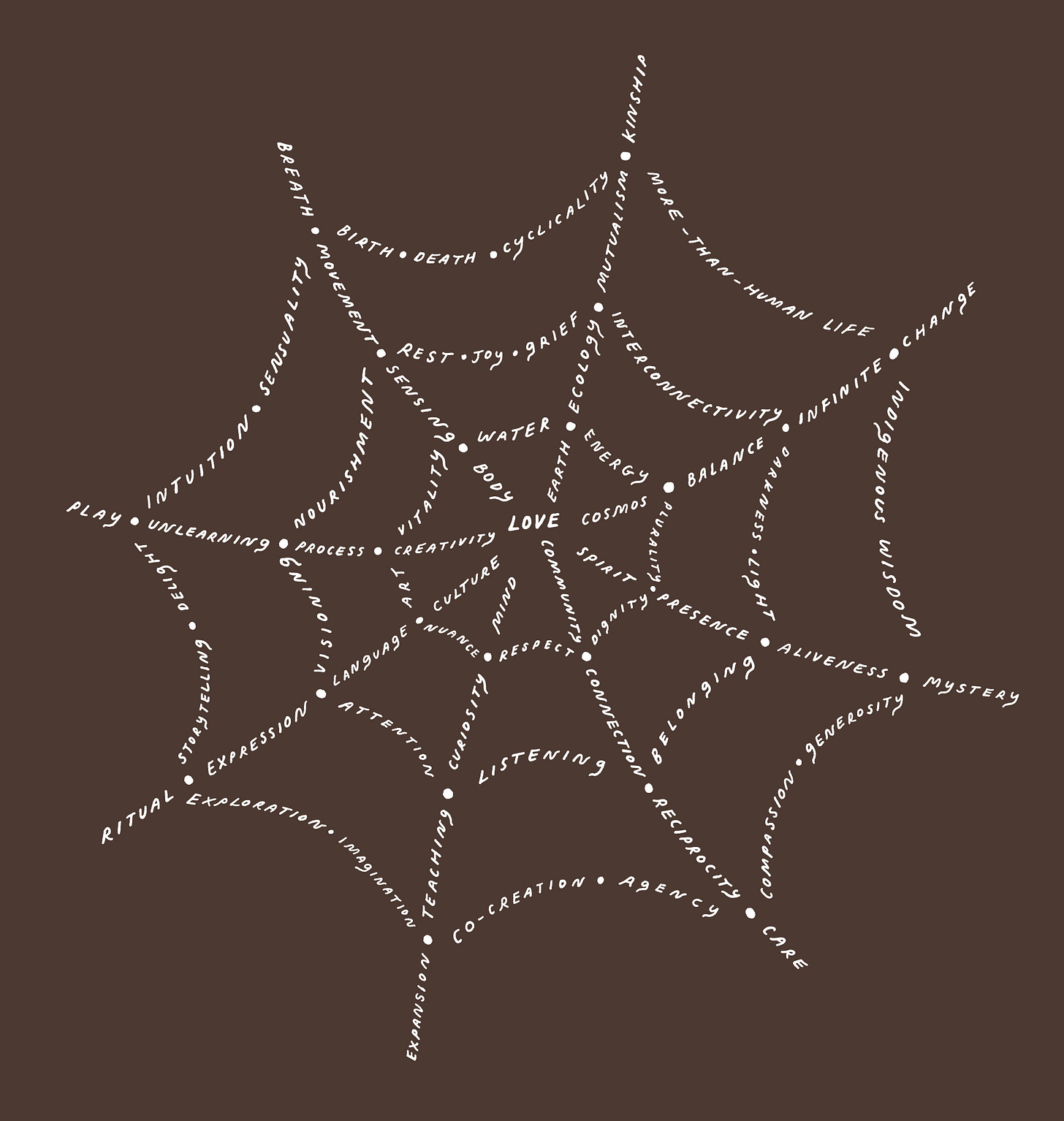
Another artist who is thinking about webs is Tess Rubinstein4. While lately I’m exhausted by words, Tess has figured out how to give them a second wind. Forming a support system of their own, words like belonging, listening, attention, storytyelling, care, generosity, rest. Threads connecting to one another. At the center? Love.
These are soft webs. Human webs. More-than-human webs. Webs that I think are an antidote to war and violence and greed and abuses of power.
3. Taking Care of Each Other is the Radicalism of Our Time
Both Lukaza and Tess explore the idea of kinship in their web work. Kinship: formally, it means blood relation, but it’s more expansive than that. Kinship is based on sharing: sharing proximity, sharing values, sharing history, sharing experience. Sharing a stake in a collective future.
Tonight we shared dinner. And I think that here, among friends and strangers, we practiced, enacted, and formed a kinship. I look around and I’m so heartened. For the first time in a while I feel like I have an answer. No, not THE answer, but one of many answers to the question of how to tend to the ache.
In this room tonight are people I’ve lived with, people I’ve crushed on, two people who helped me birth my child. Many studio neighbors, many collaborators. One person I met at summer camp when I was 12.
I feel so lucky that you’re all in here, and I want you all to know each other, and to take care of each other. Years from now I hope you’ll say, “I remember when we met at that Headlands dinner!”
When I feel isolated in my individualism I suppose I just have to remember to text all of you. The web is all around us, and we’re strengthening it just by being here.
And so. If you are looking for a balm to heal the burning fires of fascism, dinner together might be one way.
In the book Tending the Wild, M Kat Anderson wrote about the food practices of indigenous Californians:
“The traditional themes associated with food among California tribes were positive and life-affirming: mutual care, generosity, sharing, neighborliness, festivity, gratitude, abundance, and religious ceremony.”
I don’t know about you but I feel a lot of these energies moving around in here tonight.
I saw this bumper sticker last week, on a car in the parking lot of the health food store. And it just… hit right. The last few years have radicalized me in a lot of ways, but I want this to be the way that I am most radicalized.
I think taking care of each other could also be the radicalism of our time. Sure, it’s related to compassion, but it’s an action.
And if having dinner together is taking care of each other — which I think it is — then having dinner together could also be the radicalism of our time. I guess what I’m saying is maybe I should make a couple of new bumper stickers.
I deeply believe—and have had it proven to me in the last few months, in this weird liminal time between election and inauguration—that the simple act of hanging out with friends is critical. It’s not just what’s going to help me cope with the devastating state of the world, but is a way to strengthen the web, which itself is a form of resistance — against isolation, against American individualism, against consolidated power. I swear. Tending to the the web is an antidote to violence. Having dinner together is somehow the opposite of the doom.
I must now be very clear: I’m not trying to tell you that having dinner with friends is all that we need to do to counteract fascism. Far from it.
I often see this Diane di prima quote posted around the internet:
NO ONE WAY WORKS, it will take all of us
shoving at the thing from all sides
to bring it down.
This is the last chunk from a poem called “Revolutionary Letter #8.” Taken out of context, this fragment gives me total permission to call dinner a form of resistance.
But the rest of the poem is a list of tactical ways to protest. Actively, with your body. With a group of people, in the streets.
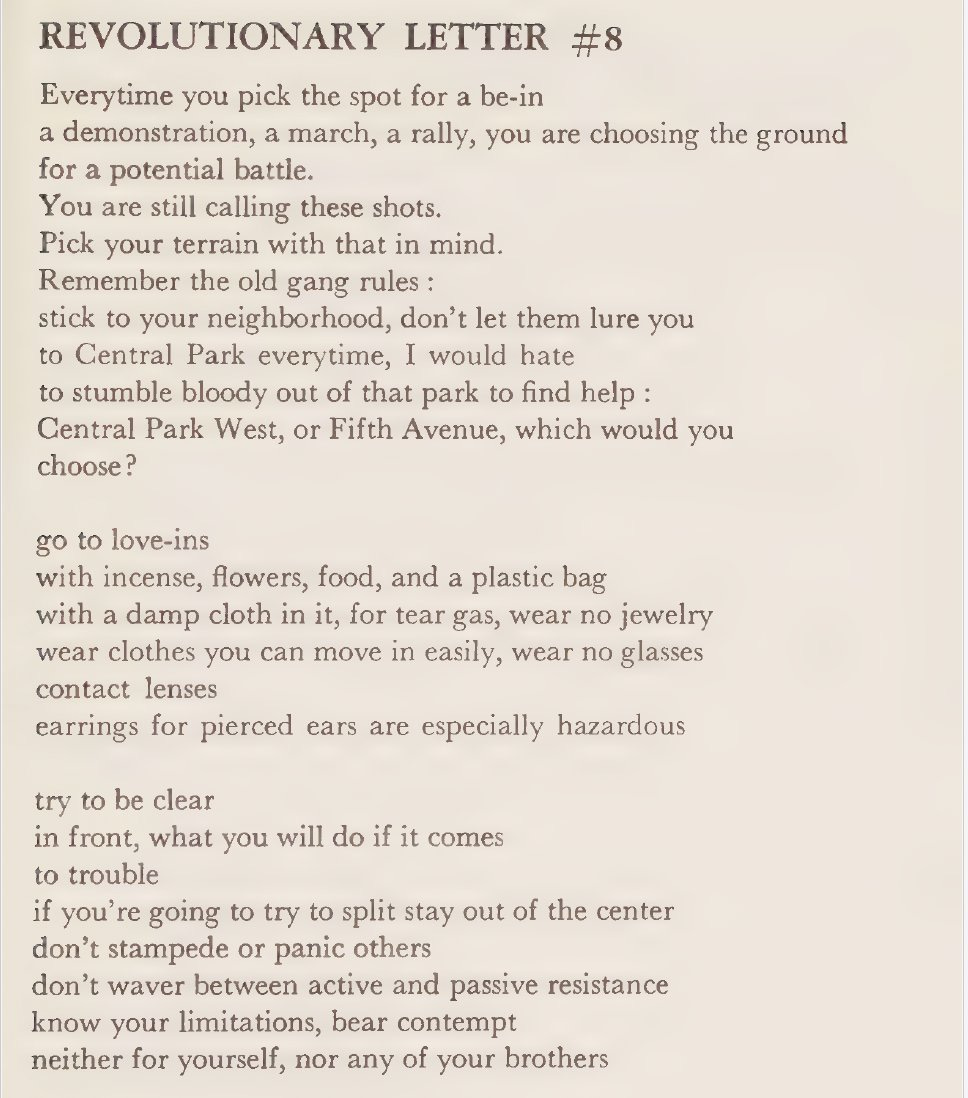
So, you know, there are many ways. Dinner may just be one of the ways to shove at the thing to bring it down.
4. Remediation as Futuring
We’ll come back now, to where we are: The Headlands Center for the Arts, the former Fort Barry, the stolen land of the Coast Miwok.
A fascinating and complicated and ever-evolving place, an example — of not necessarily how to bring something down, but how we might remediate damage.
This space once housed soldiers, in bunkbeds from wall to wall. I don’t know why but I picture them at least three bunks high. Young men preparing for war, being trained for violence, to protect an imperial power (us / U.S.).
And now it’s a place for generative energy. Here is my studio in 2016, up the hill in building 961, in what I always understood to be an ammunitions warehouse.
The act of reclaiming a place that once pointed towards violence and repurposing it for art, for food, for music, for gathering, for quiet… is exciting. I cannot think of a higher use or a better way to energetically remediate this landscape. I thought about this every day I worked here, sometimes with harp music wafting from across the road, often with quiet shuffles of other artists working down the hall. Thank you, artist squatters of the early 1980s, for your vision and perseverance.
On the phone the other night, Stephen said, “Headlands is an interesting template.” I think he’s right. This place is a model that we should recall and repeat as often as possible. The notion that a military fort, surrounded by hills full of buried bunkers, could become anything other than a military landscape was likely unfathomable at a certain point. But still, it happened. This place happened.
It’s neither perfect nor finished; remediation is a long, engaged, forever-process. Really, what good thing—what alive thing—is ever perfect or finished?
Try this thought exercise: What if, instead of our primary time-travel experience with Headlands being transportation to the past (via the palpable experience we have within these historic buildings, layered with context and energy…)
…we were to consider Headlands a landscape of the future?
What might change, for us, in our perception, in our stores of hope and motivation to reimagine and act, if we saw this place as being the AFTER?
What can this reframing offer us, as we move forward in other arenas, seeking to repair other places, processes, structures, relationships… that are damaged by imperialism, by brute force, by misplaced power?
If this ongoing, dedicated, active repair can occur here, where else in our world, in the Bay Area, in our lives, might it happen?
5. There are many ways
There is so much to think about at this moment. Tonight, instead of sharing a project that is finished, you’re catching my artistic process, my real-time unfolding of thoughts and feelings and connections and ideas. And lots of questions.
I leave you not with a single conclusion, but a few of them.
Because there are many ways.
My hope is that we can spiral INTO shared threads of connection, instead of spiraling out. My hope is that we can commit ourselves to strengthening the webs between us, commit to building a net to catch us. My hope is that we can learn together — not alone — how to become better equipped to counter this dark moment.
When Cathy and I were back at my house after the lemon walk, braising chicken, I asked her if she thought the premise of this talk was enough: to introduce the anxiety spiral and then offer, as an antidote, the importance of taking care of each other and being together.
And she said “Yeah, it has to be enough. It’s all we’ve got.”
The artist Daniel Glendening5 wrote:
“Art is not an effective counter to capitalist fascism. Art can be, though, an effective counter against despair, and sometimes that's enough.”
I wonder if the same thing could be said about hanging out with your friends, or about taking care of each other, or about having dinner together.6
Thank you Daniel for this thought, thank you Damon for this dinner, thank you Stephen — and MJ and Juliana — for this invitation, and thank you everyone in this room, for being here together to share food, to share attention, and to work together to strengthen the web.
May all of you, and may all beings, find peace.
Thank you.
Thanks for reading my talk-as-newsletter! It feels good to give this thing a life beyond a single moment.
POST SCRIPT
I’m trying to shift my exposure to the doom spiral, and making an effort to swap media recommendations directly with friends, instead of relying on social media. Just one part of the weaning. Here are a few things I’m consuming lately.
We’ve tuned our kitchen radio to the local classical station (thank you KDFC) instead of NPR, and the breakfast vibe is much more sustainable. (I make exceptions, of course, for KQED’s Forum.) At other times, it’s KWMR, West Marin Community Radio. My faves are Sunday mornings with Second Breakfast and Earth Baby Radio, Sunday evenings with Sincerely Radio, and Wednesday evenings with West County Prowl.
I subscribed to Rebecca Solnit’s new newsletter, Meditations in an Emergency. It feels like the thing I want to tune into at this moment. Apparently 11,000+ other people thought so too!
I signed up for Bluesky, but realized quickly I am more motivated to squat on my username that I am to use another platform… maybe if Instagram becomes irrelevant we’ll all finally be free?
I really enjoyed reading Willa Köerner’s essay “Social media is cooked,” from her Dark Properties newsletter. Super relatable as a fellow millennial whose early adulthood / creative career genesis was shaped by the rise of social media.
I read with interest (and a sinking feeling in my stomach) the artist Thibault’s newsletter about considering leaving Substack after yuck comments by its co-founder. I’m thinking it all through. I feel like I just got here but I also can’t ignore the feeling that I don’t trust a VC-funded, Nazi-sympathetic platform for a second. Non-profit, carbon-neutral Ghost, here I come?
Last weekend I attended an event hosted by Point Reyes Books: a conversation between authors Rebecca Solnit and Lauren Markham, to commemorate Lauren’s newly published book, Immemorial, from non-profit Bay Area publisher Transit Books. The packed house on a Saturday afternoon confirmed my feeling that being together, in person, is really important right now. Also Lauren’s book sounds very good, I’m excited to read it.
Speaking of books, I have leapt with abandon into the BookTok zeitgist of romantasy books and I’m not embarrassed about it at all. After finishing ACOTAR and listening to this episode of the Culture Study podcast, any sense of shame I felt has been replaced with curiosity. I also finished the Empyrean and Crescent City series, and I’m quite compelled by the way these escapist, YA-adjacent novels (“new adult,” they call it) are somehow, at their core, about resistance to authoritarianism. Really? Really! The protagonists, though quite flawed, are fighting against tremendous odds for just and equitable futures, with distributed power and human/fairy rights for all. My criticism about the problematic dimensions of these series aside, I swear to god the fairy smut books are kind of about social justice. Or, that’s how I’m choosing to read them. Let me know when you want to talk about them.
Farewell for now, and thank you as always for reading.
Another good piece that explains things: “Win for environmentalists at Point Reyes is a loss for almost everyone else”
Can’t add a footnote to a caption, but here’s where you subscribe to Sophie Wood Brinker’s newsletter.
Subscribe to Lukaza Branfman-Verissimo’s newsletter: ROOTS WEBS NETS BRANCHES BULLETIN BOARDS
Subscribe to Tess Rubinstein’s newsletter: Notes on Noticing
See Daniel Glendening’s project space in Santa Rosa, California: Labor is a Medium
At the Rebecca Solnit / Lauren Markham conversation, Solnit spoke of how important face-time with each other, in physical space, is in this moment. Talking about the room full of people, she said, “This isn’t the action, it’s the preparation.” I appreciated her clarity. It’s not the thing, but it’s part of the ecosystem of things.





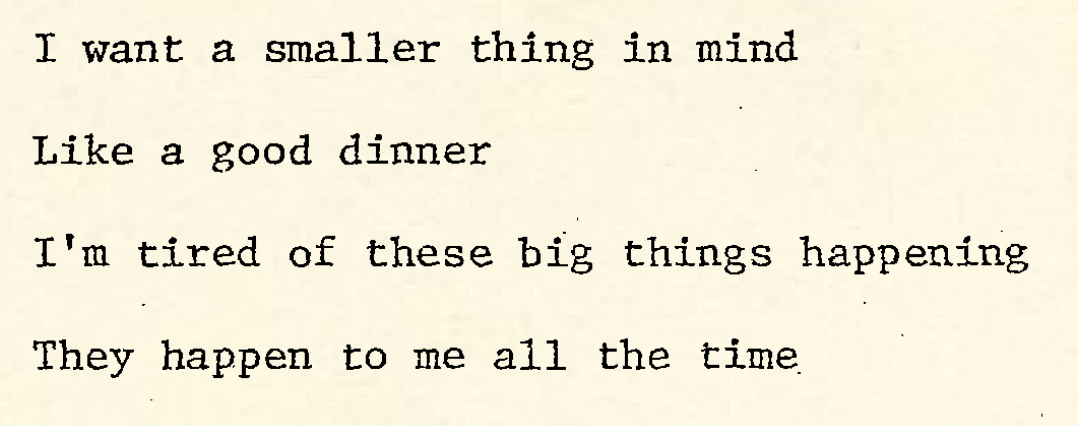
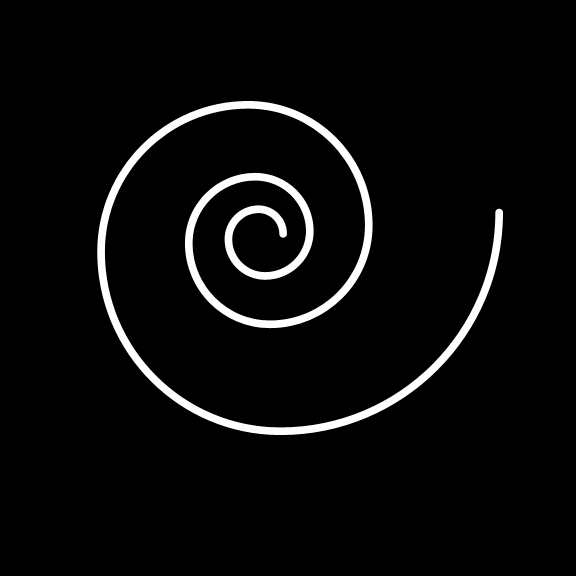
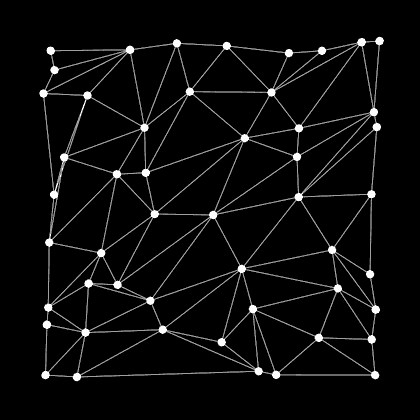
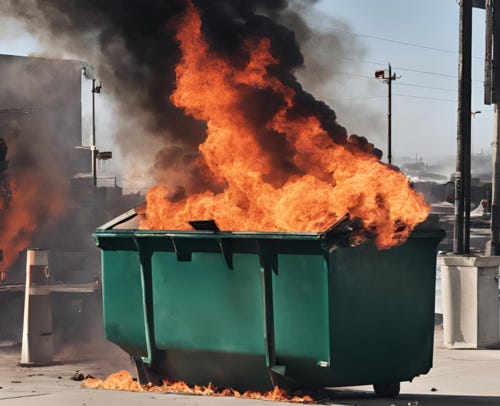

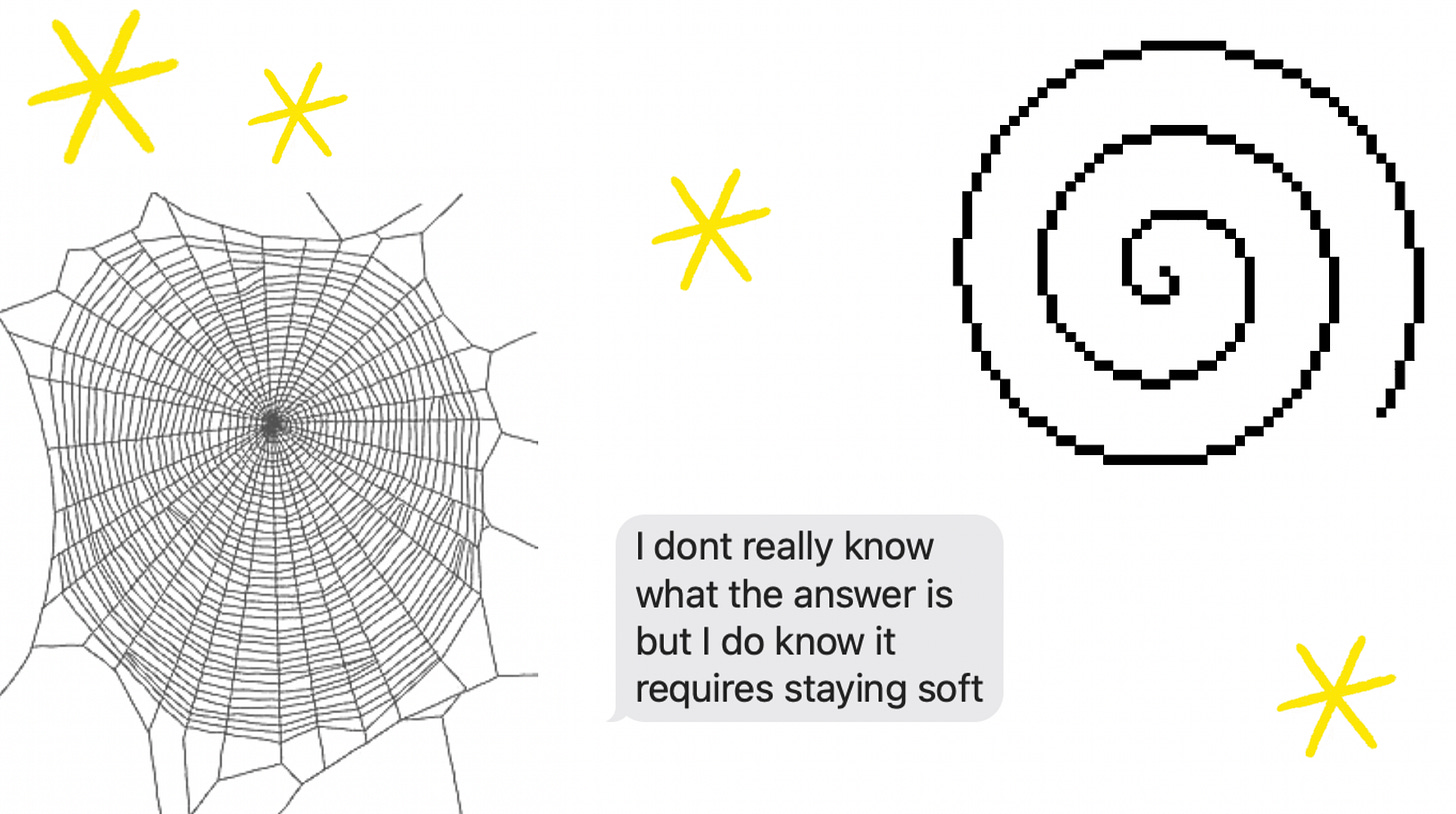


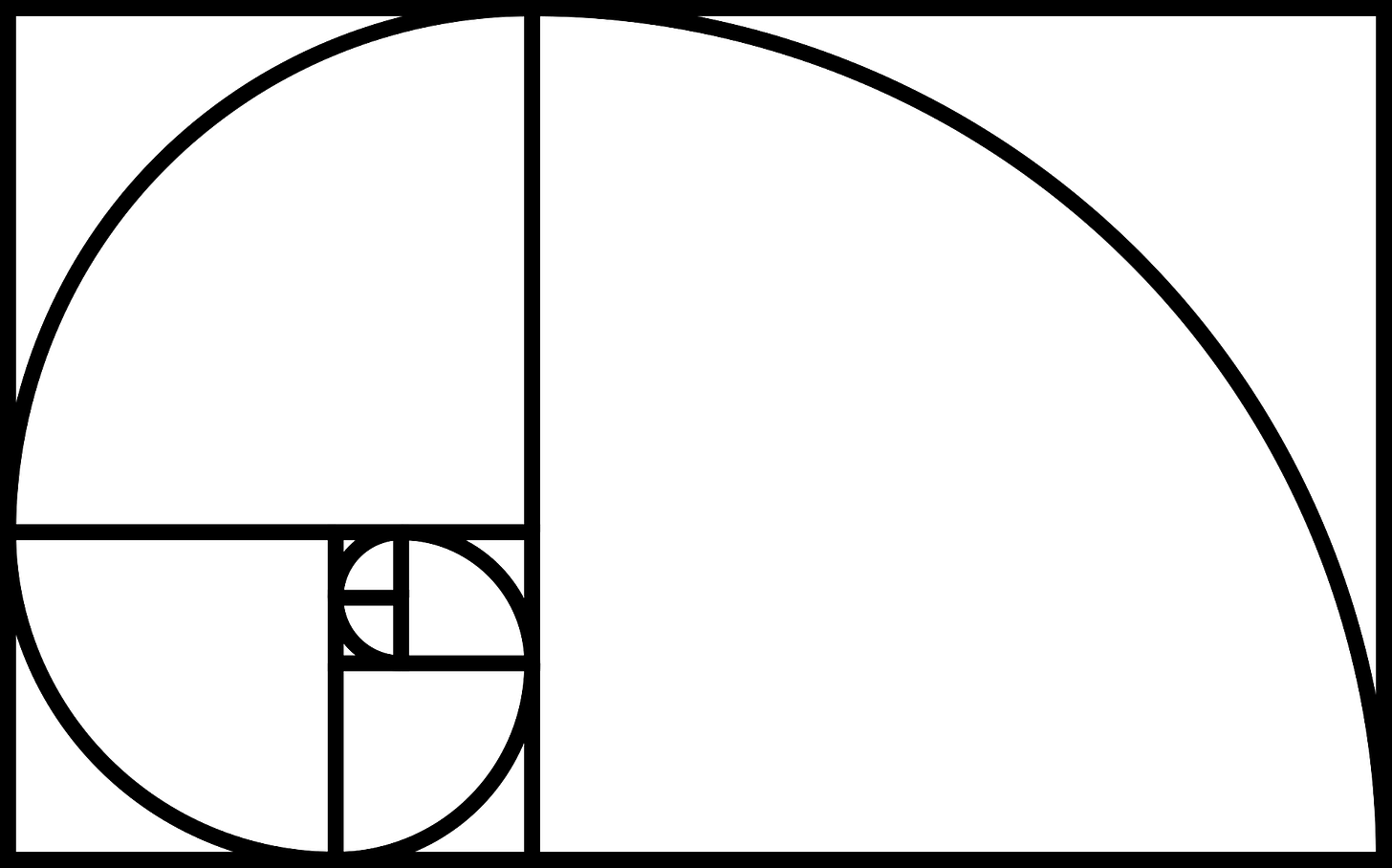
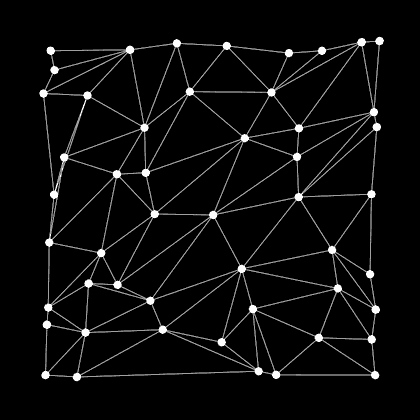

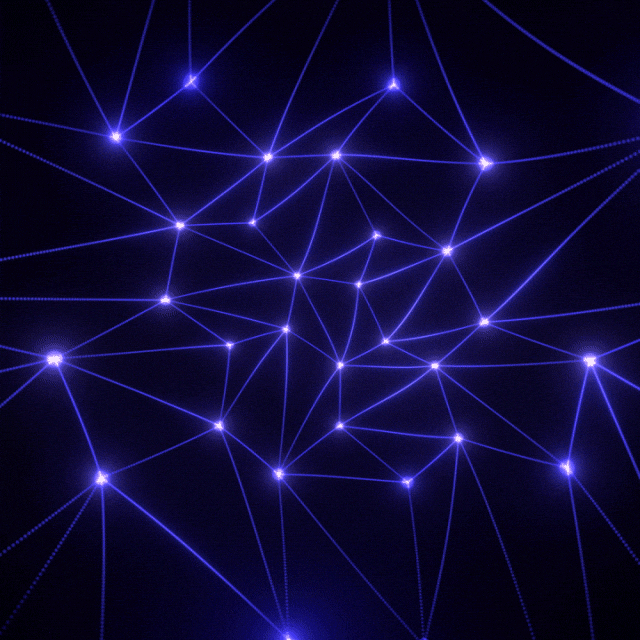

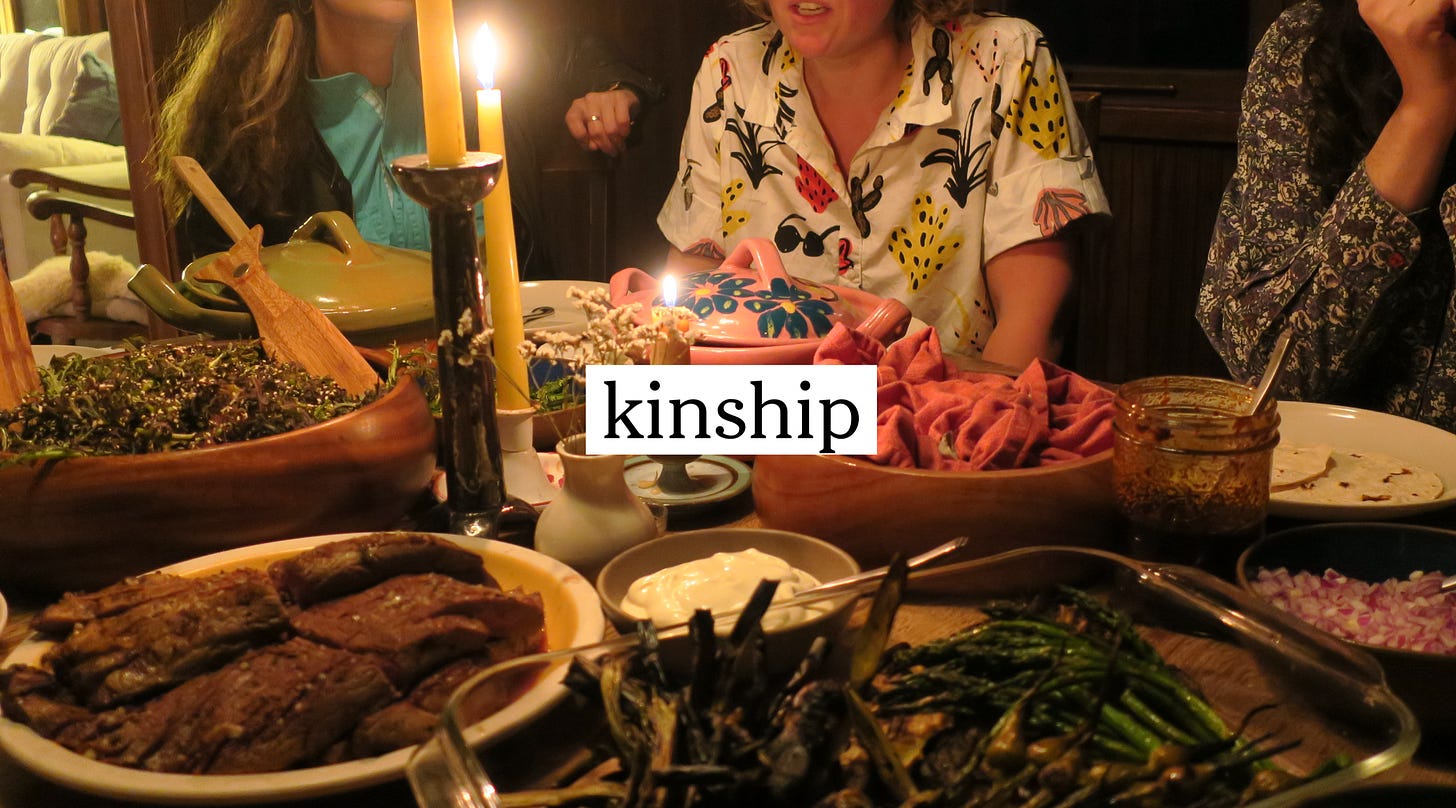
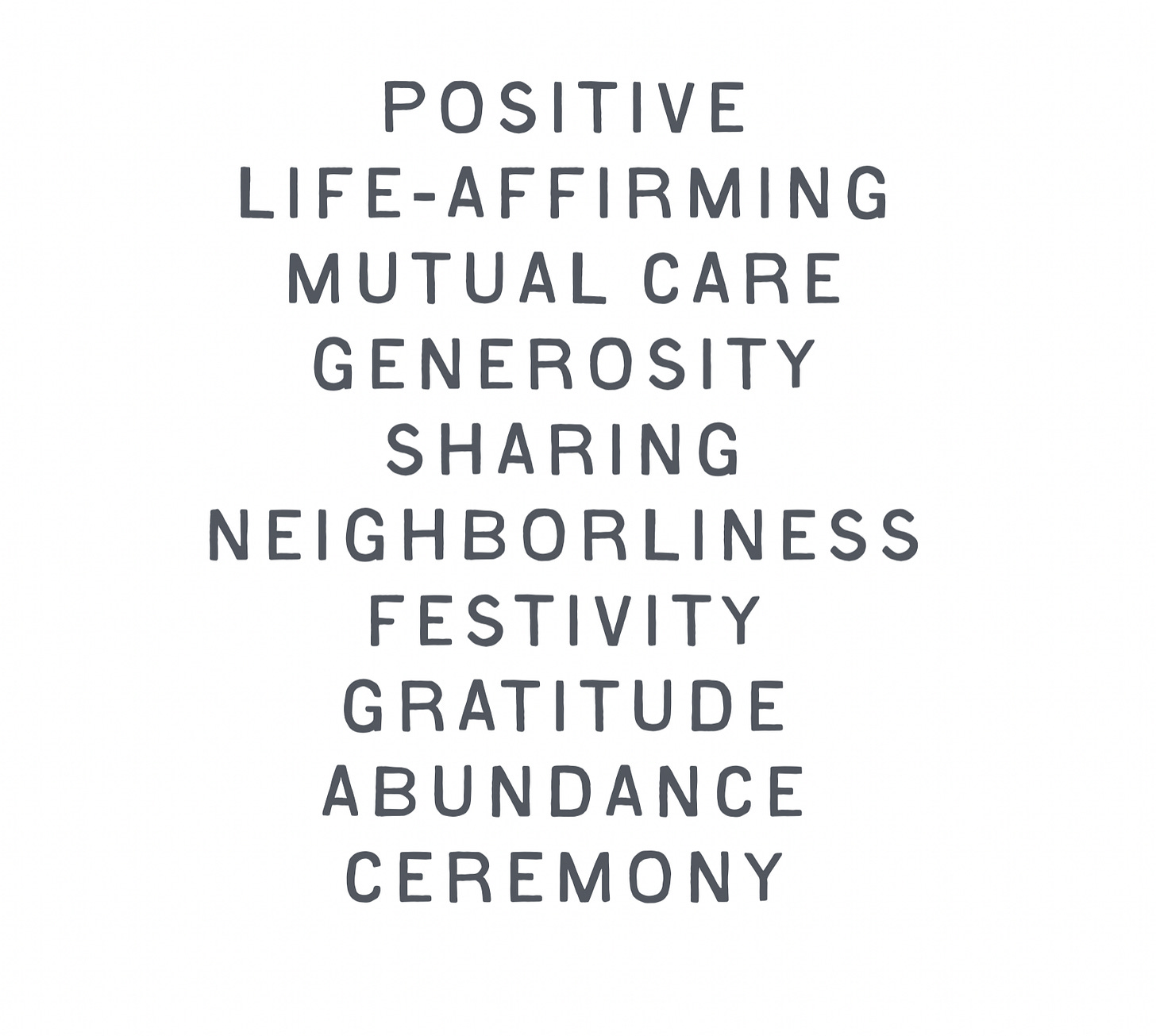
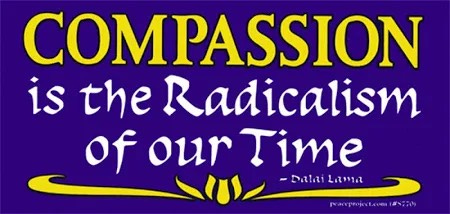
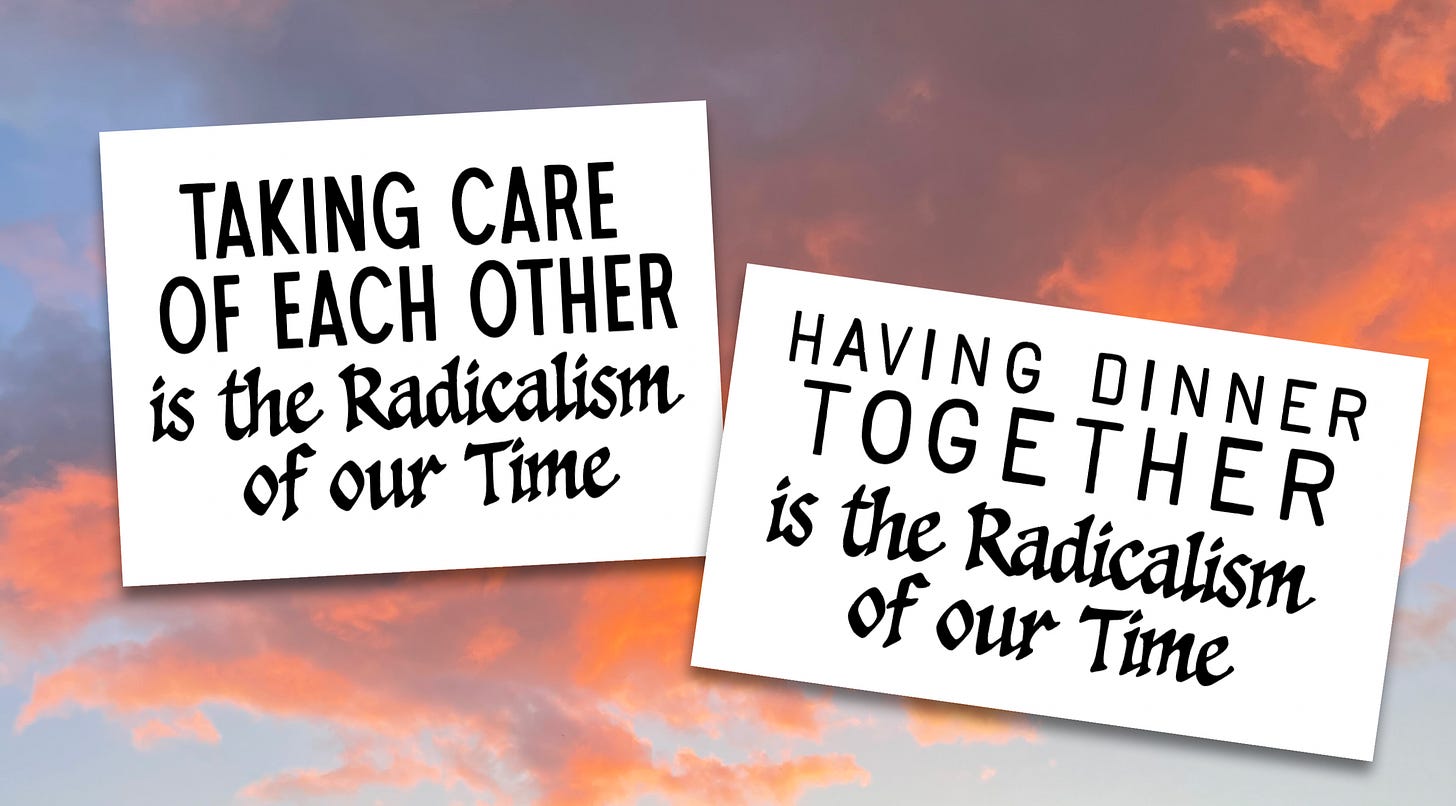
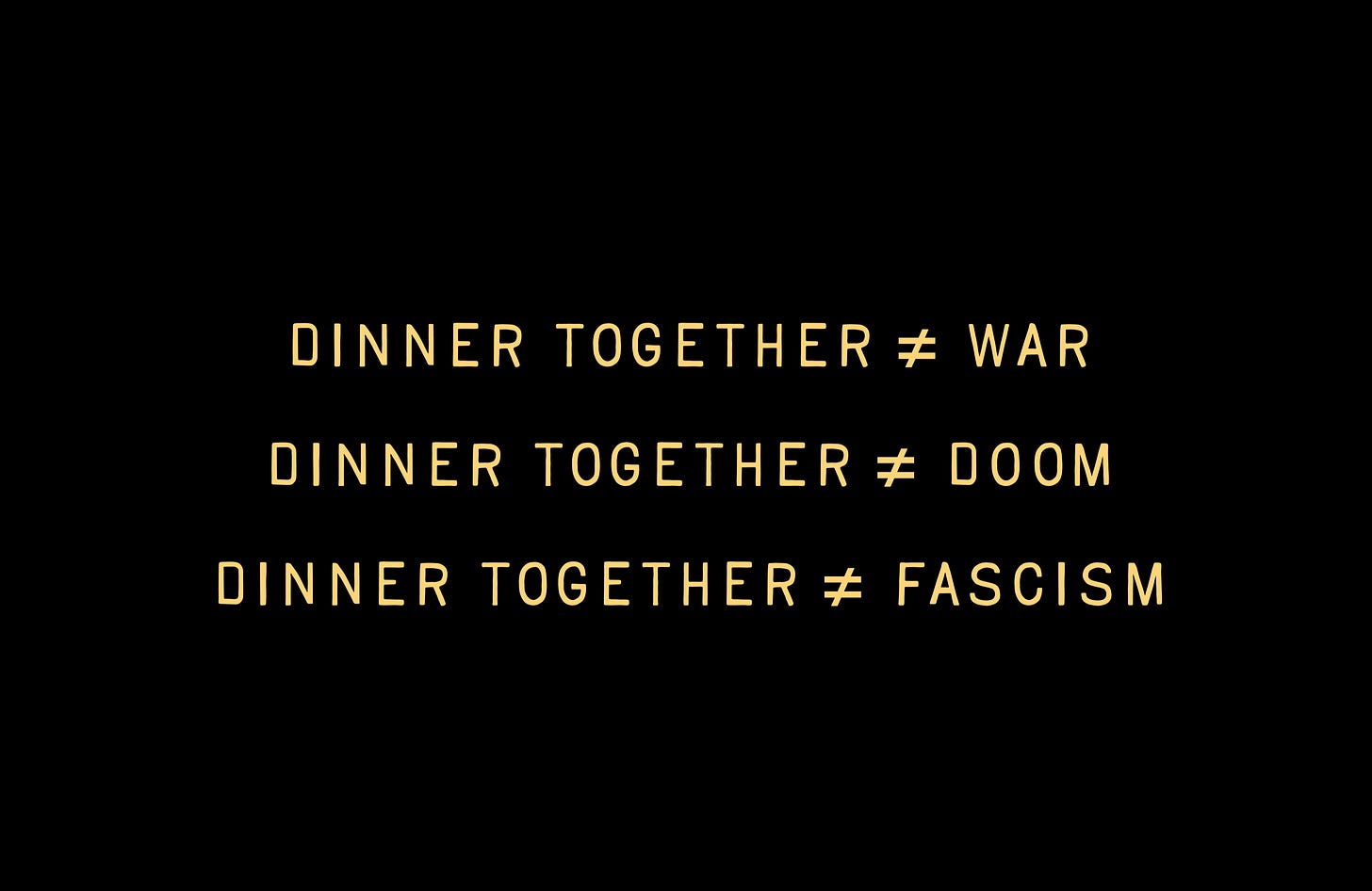
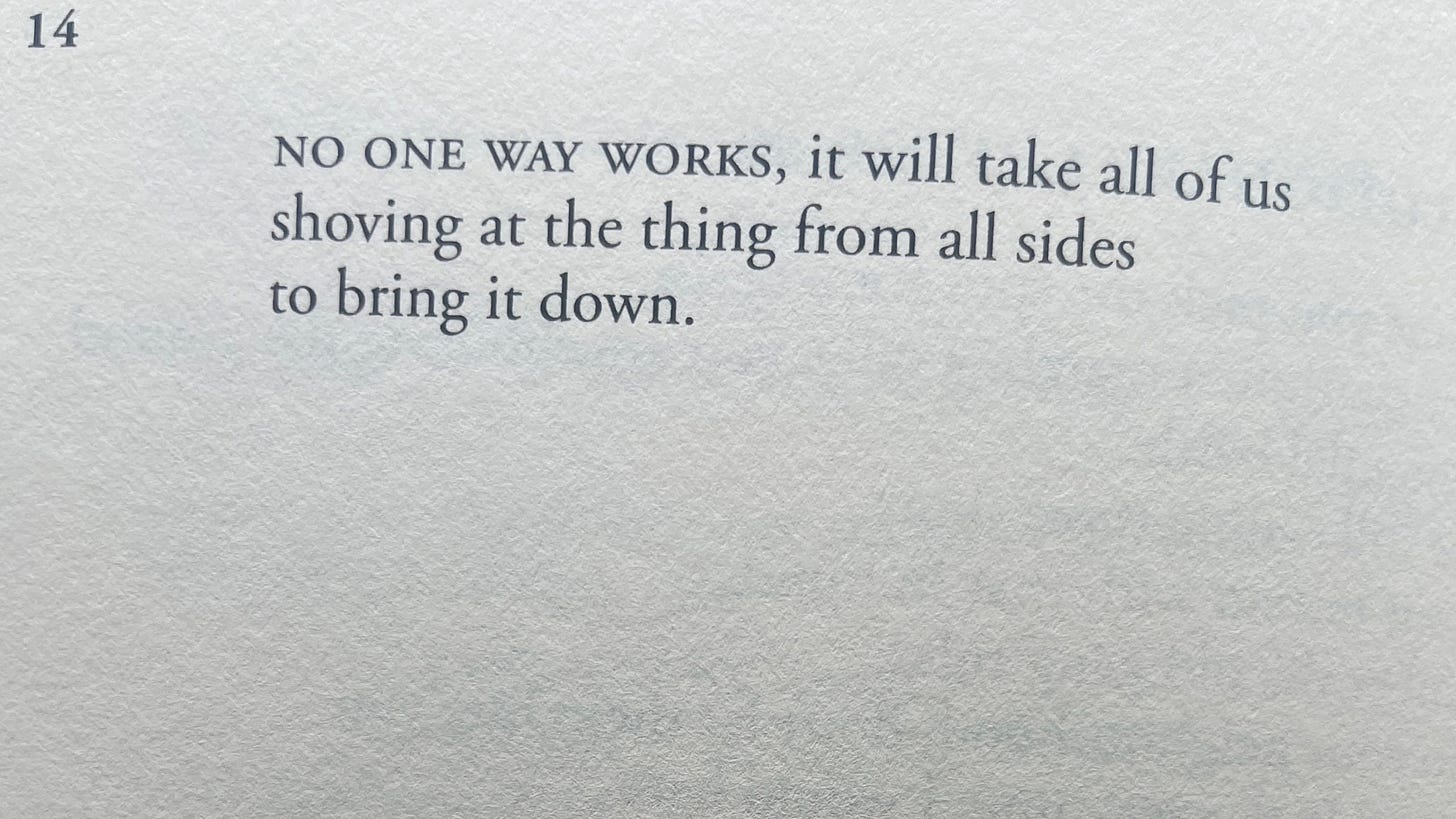
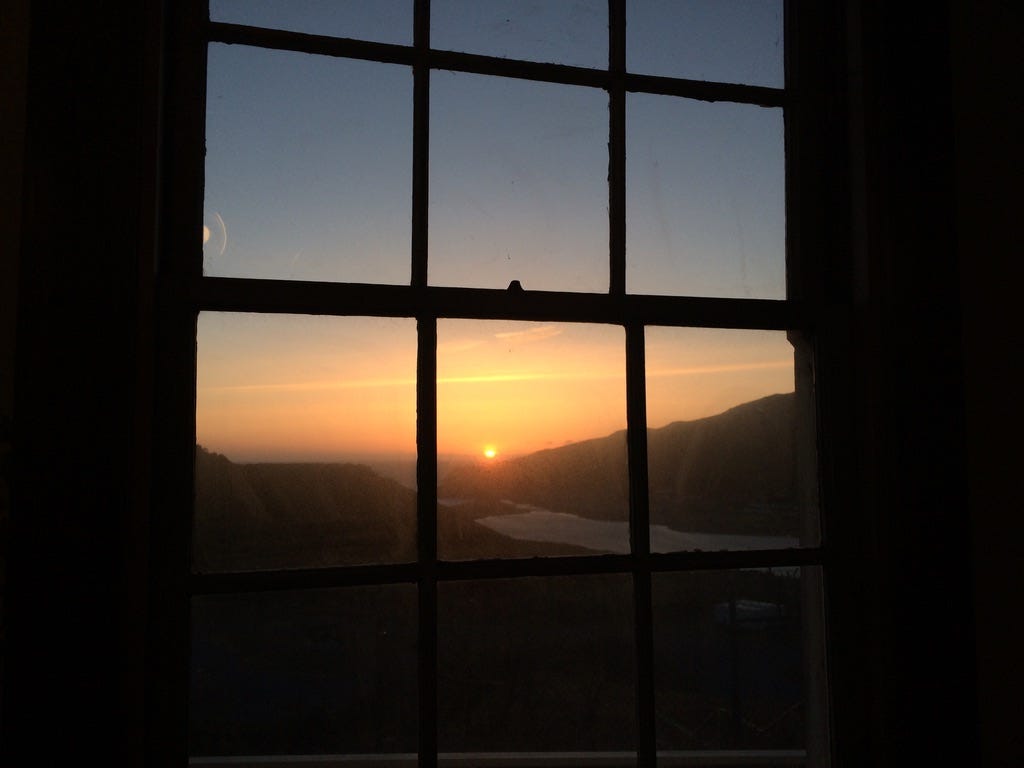
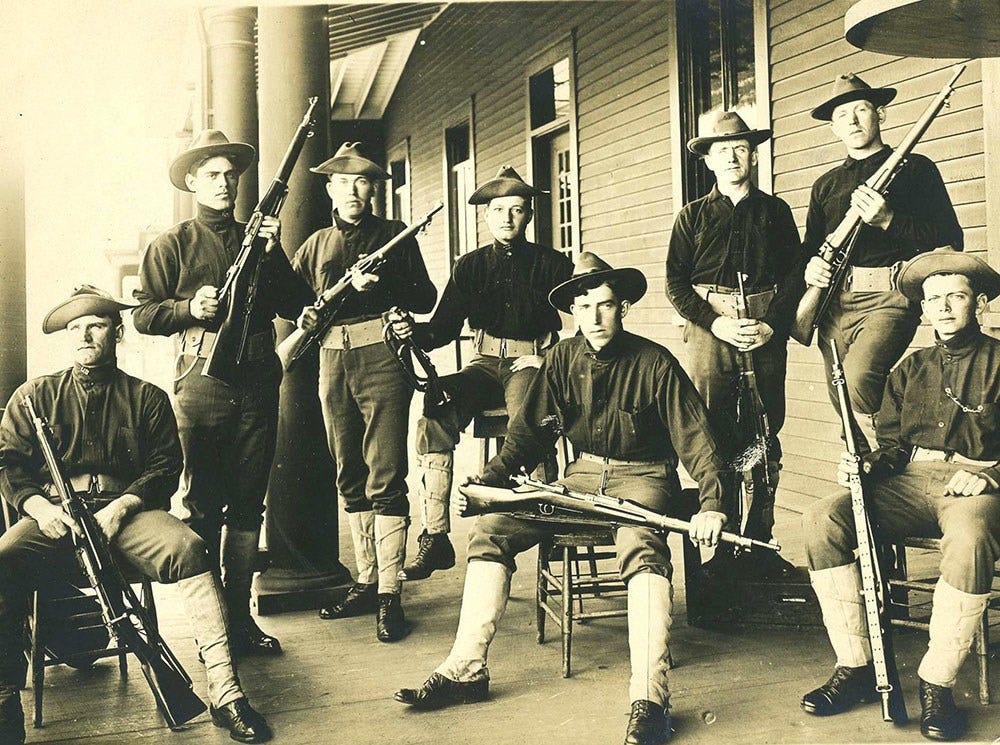
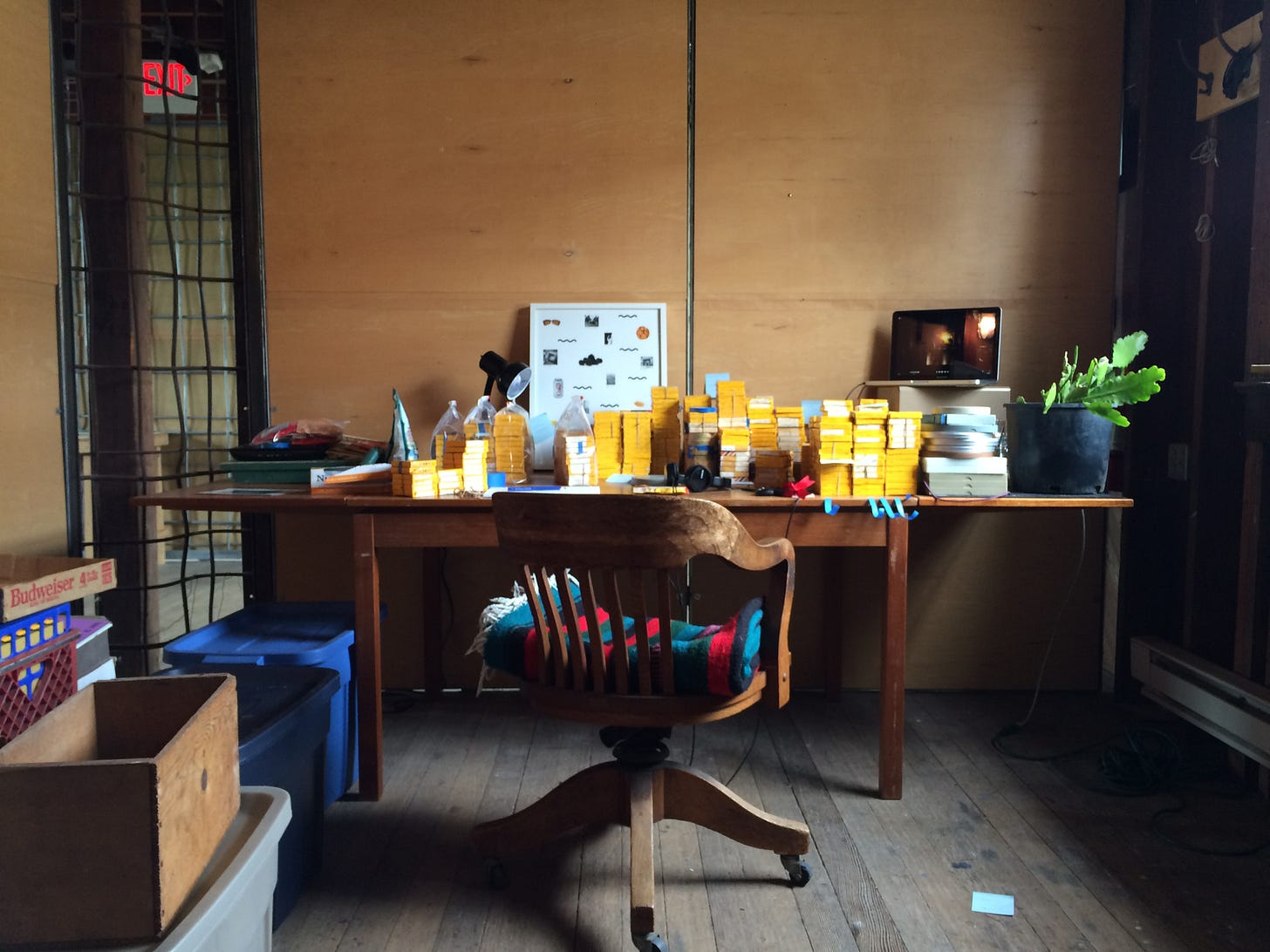
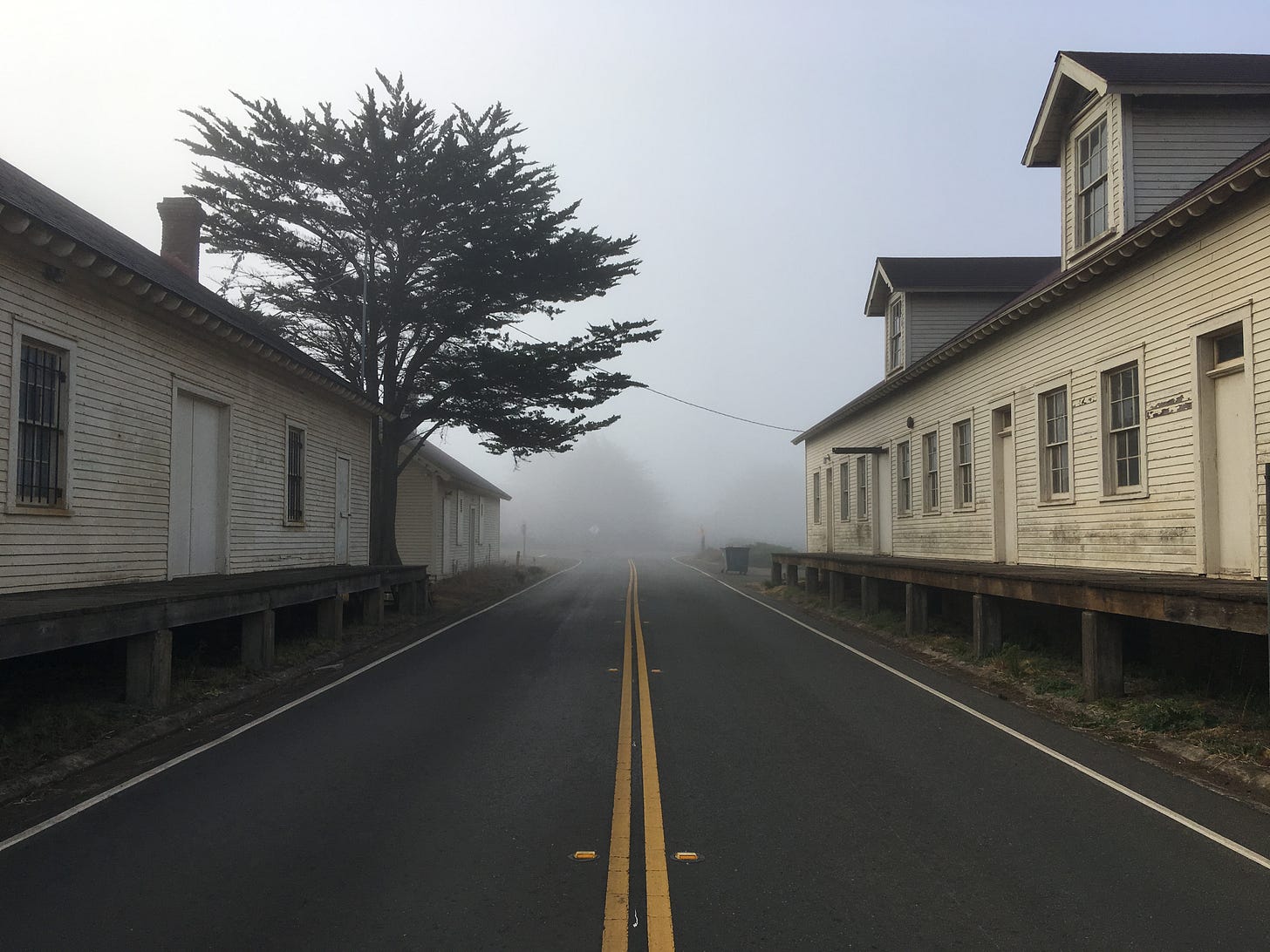
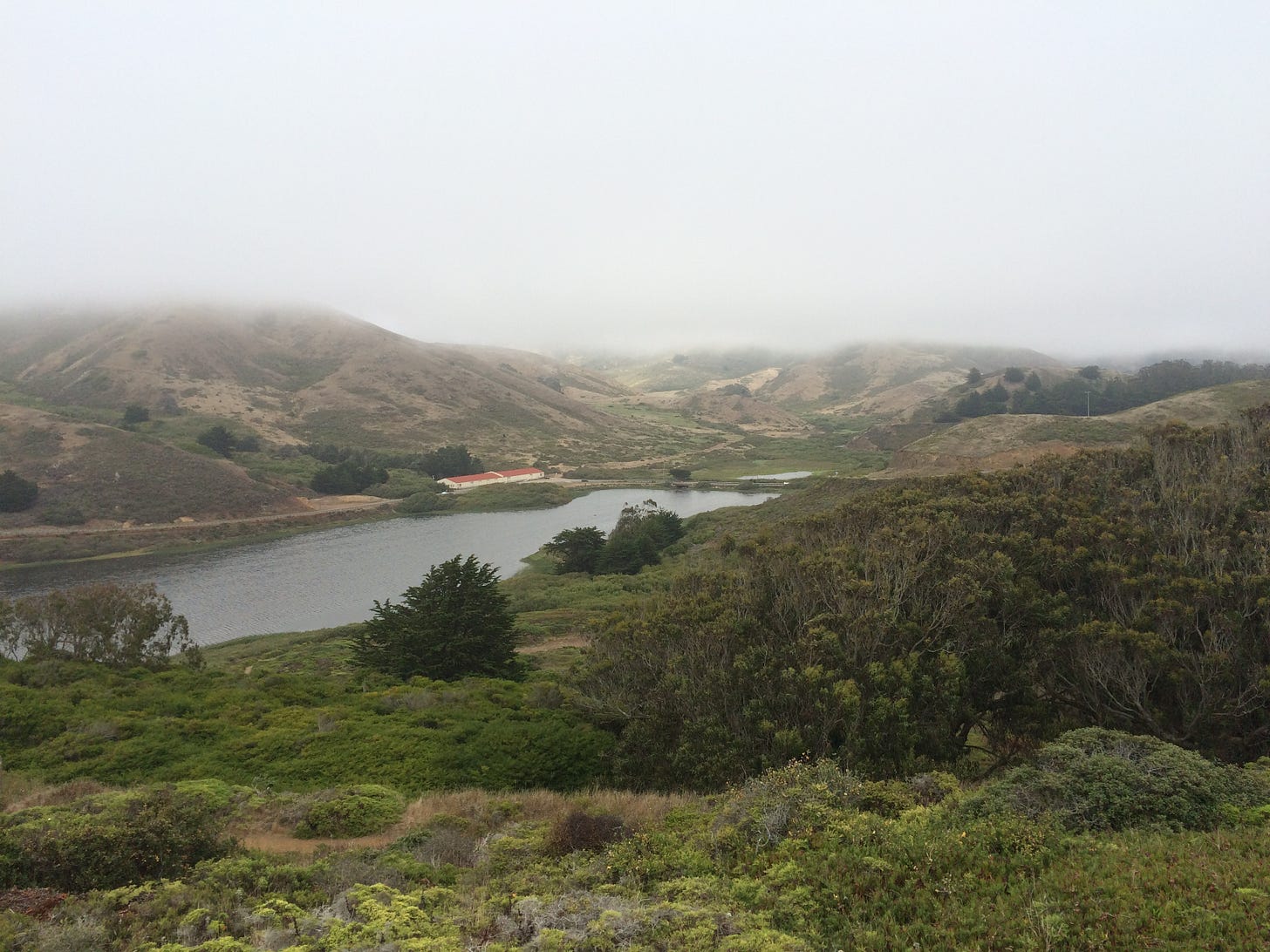
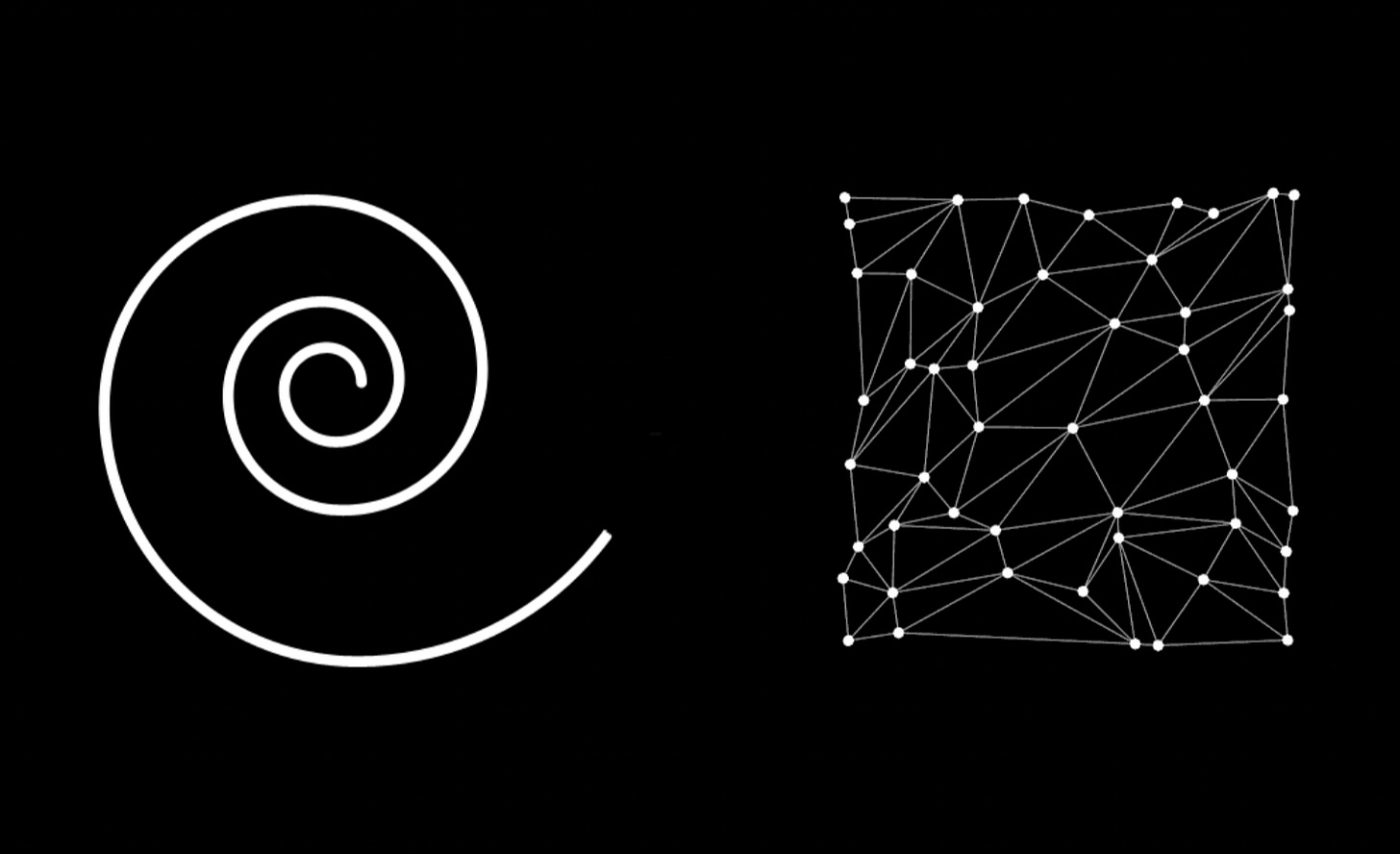
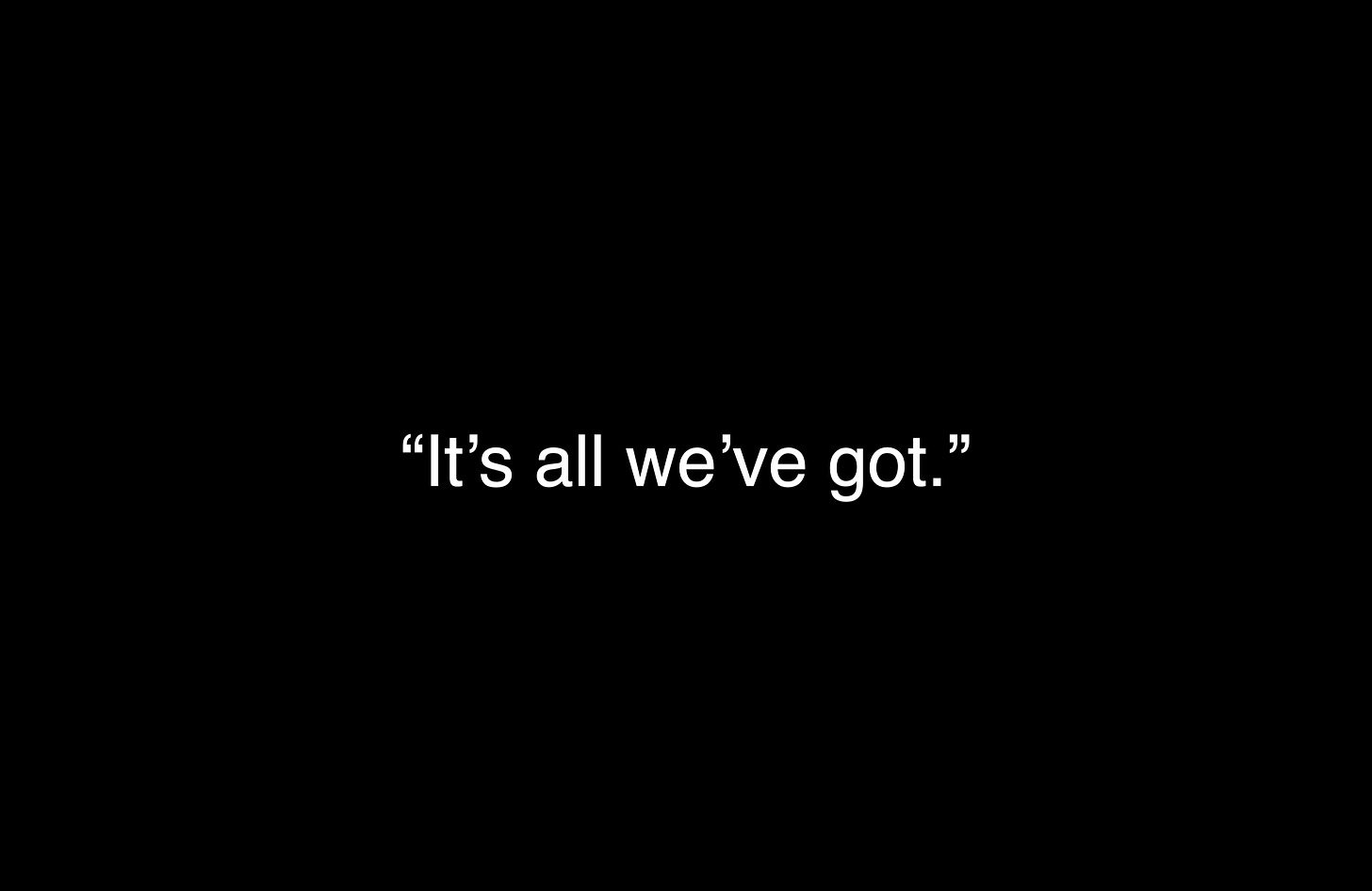
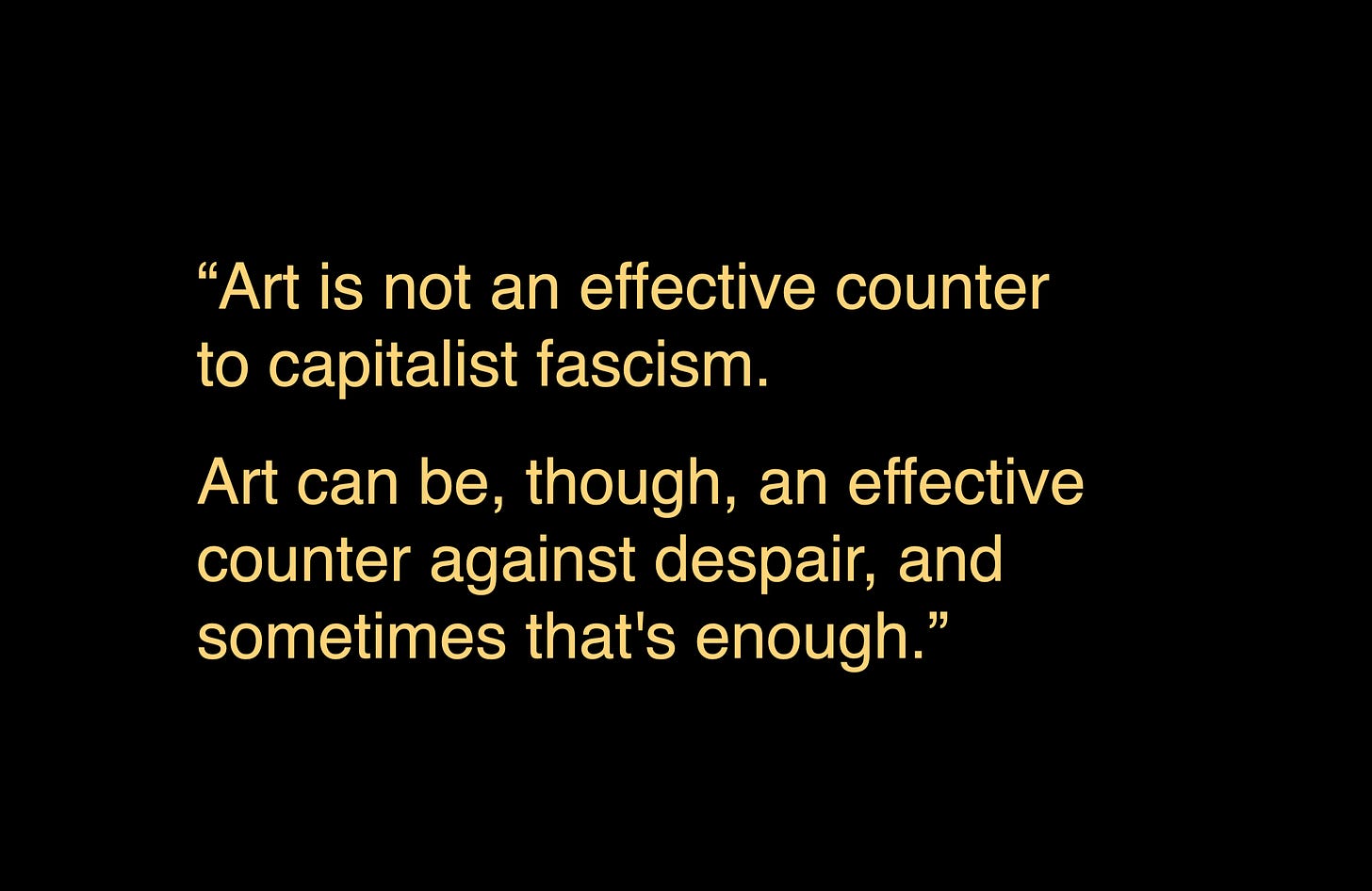
Thanks for this. This is not nothing, it's everything. And yet so elemental and clean.
I'm so behind, but I did it; I spiraled in. Also, glad I made it to the end to have "fairy smut" in my things to look out for list. Appreciate you always...